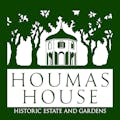The Evolution of the Houmas Estate

The Houmas residence began as a humble two-story structure in 1774, built by Alexander Latils and Maurice Conway, and is referred to as “The French House. It was constructed of brick and cypress with 18” thick walls on the first and second floors. The original cypress beams and rafters are still visible and today the building forms the rear of the mansion and is separated from the main structure by a carriage way.
The Houmas property had changed hands several times between 1774 and 1805, when two Englishmen acquired the plantation and began construction on a new home which they positioned just a few yards in front of the original French House. Known as the Donaldson House, it was a simple Louisiana cottage of brick-en-post construction with a center hall and four rooms. Fronted with a colonnade and topped with a typical hipped roof, the cottage rested on brick piers about 3’ above ground level. That structure remains today, encapsulated within the mansion and incorporates the present Dining Room, rear Center Hall, Billiards Room and parts of the Oval Room.
General Wade Hampton acquired the plantation in 1811 and began remodeling the Donaldson House in 1817. The house was enlarged at the rear and the colonnade was extended around the entire structure. It is also believed that an attic floor was added, as well as dormers and an interior staircase. Two of the 1817 columns remain within the carriageway of the house along with the original front door. The 1817 windows are still are still visible on the side elevations of the house.
In 1829 General Wade Hampton began construction on today’s classic Revival structure- the Houmas Mansion. A grand colonnade was added with fourteen massive Tuscan columns, which rose on plinth blocks and towered upwards of two floors. The third floor of the mansion was hidden behind a large pitched and gabled roofline, pierced with seven classic revival pilastered arched dormers. The large roof of Houmas was crowned with the grand cupola and belvedere, allowing for an expansive view of the river, as well as the bountiful cane fields and numerous plantation buildings.
Changing ownership several times from Wade Hampton to Williams Porcher Miles, in the 1890’s the mansion was enlarged again by connecting the 1829 mansion to the French House in the rear. The carriageway was created between the two buildings and two additional bedrooms and a center hall were added to the second floor of the mansion. During the Miles period, the second floor housed seven bedrooms.
In 1940 Dr. George Crozat of New Orleans purchased the home and remodeled the classic revival mansion to a Williamsburg federal-style country home. Numerous out buildings were demolished, including a schoolhouse, a pair of pigeonierres, five water cisterns, stables, service quarters and dozens of small service buildings. Dr. Crozat furnished the mansion with federal and early Louisiana antiques.
In 1968, upon Dr. Crozat’s death, the home was left to family and was opened to the public for tours.
In 2003 The Crozat heirs sold the mansion and the entire contents piece by piece in an auction. It was here the Houmas Estate and surrounding 32 acres was purchased by current owner Kevin Kelly.
